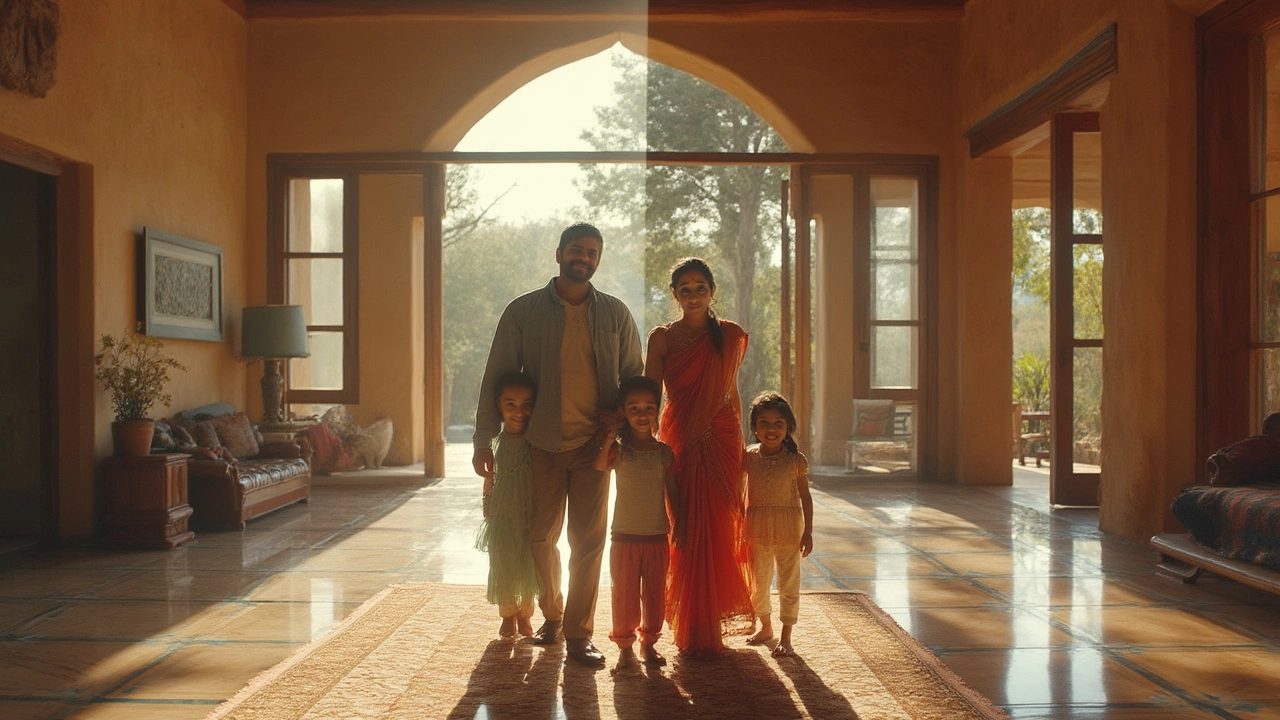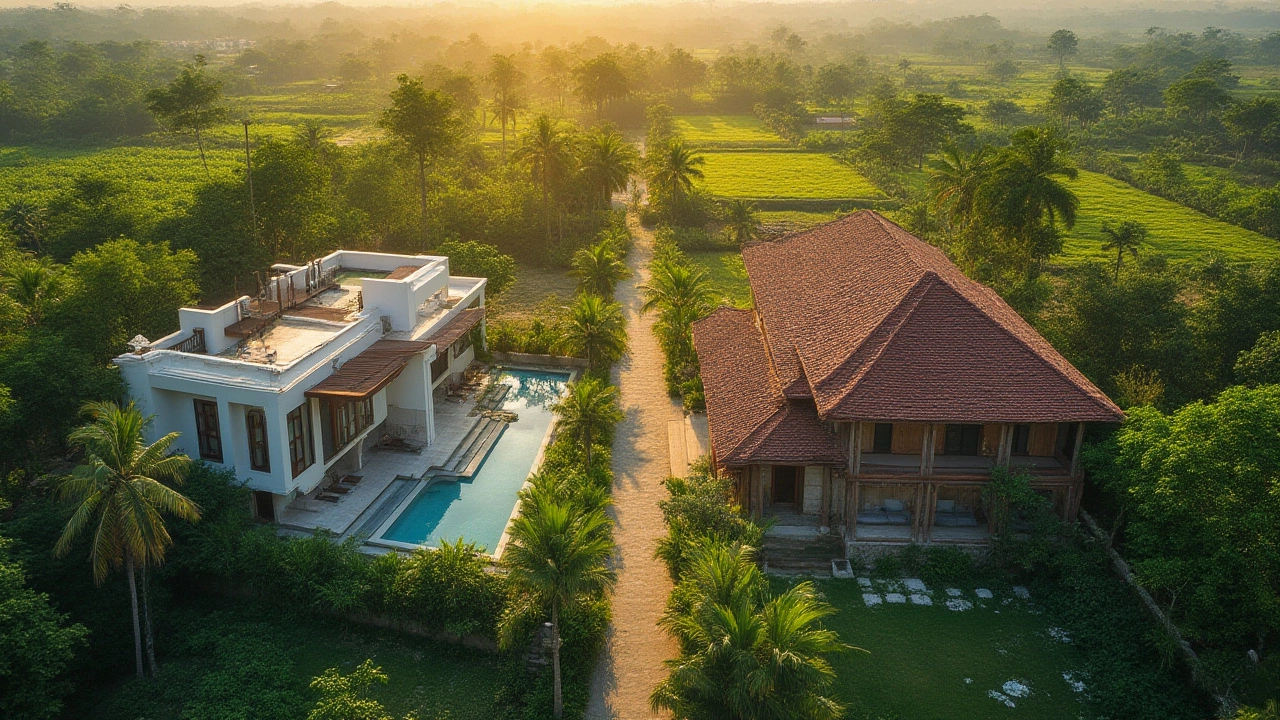Ever dreamt of wide open spaces, your own patch of green, and sun streaming through big windows? Maybe it’s a villa in a gated community you want, or perhaps it’s a farmhouse out in the countryside. The two get mixed up all the time, but believe me, there are some big—and surprising—differences hiding just under the surface. The choice isn’t just about architecture; it spills into lifestyle, maintenance, investment, and even the food you’ll end up cooking. Imagine waking up to the quiet hum of the countryside—with a rooster crowing in the distance—versus sipping your morning coffee beside an infinity pool. Each has its perks, quirks, and a fan club. But if you don’t know exactly what sets them apart, picking the right one can get confusing—and even expensive.
What Exactly Is a Villa?
Think high fences, a swimming pool, manicured lawns, and sleek modern facades—this is the picture most people have when they hear the word “villa.” Villas are usually associated with luxury. They tend to be located inside exclusive neighborhoods or gated communities, and security is often tight. Builders design villas to impress, using high-quality building materials, stylish interiors, and plenty of glass for sunlight. Pool parties? Check. Barbecue Sundays? All yours. A 2024 report by Knight Frank noted that the demand for villas in Indian cities like Bangalore, Goa, and Hyderabad grew by 21% year on year due to their privacy, amenities, and strong resale value.
Villas rarely sit alone in the middle of nowhere. Instead, you’ll find them side by side with other villas, all tucked into a planned community. You’ll often share the gym, playground, or clubhouse with neighbors but still have your own private driveway and backyard (sometimes both). Developers typically offer maintenance staff, garden care, and security, so owners don’t have to worry about the little things. The draw here is convenience, comfort, and a feeling of exclusivity—villas usually give you status, too. The design often includes contemporary themes: clean lines, spacious balconies, and sliding glass doors. Some villas even come with smart-home technology, solar panels, and underground parking. It’s like a private house, but with extra help on tap.
Space is generous. Villas can range anywhere from 2,000 to over 10,000 square feet. They often come as duplexes or triplexes, and land ownership is typically freehold. Sizes and layouts vary depending on the city and price bracket. Some ultra-modern villas offer rooftop terraces and home theatres. Others stick to more classic designs, focusing on huge living areas and sprawling gardens. And did I mention location? Villas sit close to cities, schools, hospitals, shopping, and entertainment. If you want to work remotely, there’s usually a high-speed internet line. That’s why professionals, celebrities, and high-net-worth individuals look at villas first when they want both privacy and connection to daily life.
If you love hosting parties, want minimal fuss, and enjoy clean, elegant architecture, a villa is probably calling your name. You sacrifice a bit of wildness for a lot of polish. But let’s be honest—there’s no haystack or homemade butter in sight. If you’re after that, keep reading.
What Separates a Farmhouse?
Picture a winding dirt road, open fields, and maybe the occasional cow or a plot of vegetables. That’s the soul of a farmhouse. While people sometimes confuse farmhouses with luxury villas because both sit on big plots of land, the similarities end there. Farmhouses are usually found in the outskirts of cities or deep in rural areas. The big appeal? Tranquility, nature, and space. But this isn’t just a weekend getaway—many families are starting to live full-time in farmhouses due to the rise of remote work since the pandemic. A study by Anarock in 2023 found the number of farmhouses sold in Maharashtra increased by 38% in a single year, as city dwellers sought peace during lockdowns.
The architecture of a farmhouse is nothing like a villa. Where villas are sleek and modern, farmhouses are rustic and practical. You might see sloped roofs, wooden beams, and open verandas where you can sip masala chai or read on a rainy afternoon. Some even include a barn, cattle shed, or a chicken coop. These homes often use local materials, blending into the landscape. The design generally favors utility—big kitchens to handle garden produce, mud rooms for boots, and wide wraparound porches. Some farmhouses have lush, productive gardens and orchards; others use the land to grow crops or rear livestock. The key difference? Most farmhouses aren’t part of a community. Your nearest neighbor could be a kilometer away.
Maintenance is a whole different game. Sure, you get big skies and stunning views—but the weeds don’t pull themselves, and the goats certainly don’t herd themselves. Water management, pest control, boundary maintenance, animal care, and crop rotation all become part of life. Either you treat it as an adventure or you hire help. And let’s talk about land—farmhouses almost always offer much larger plots compared to villas. Five acres isn’t unusual. It all depends on the region, though. In Haryana or Punjab, a farmhouse could sprawl for dozens of acres. In Goa, the plots are smaller but filled with coconut palms and vegetable patches.
If you’re seeking true privacy and love a hands-on lifestyle, a farmhouse ticks those boxes. Living here lets you grow your own food, ride horses, or host bonfires under the stars. The air is cleaner, the sky darker, and the only gadgets you might care about run on solar panels. But if you value next-day Amazon deliveries or high-speed fiber broadband, a farmhouse might be a shock. Newcomers often underestimate the work and isolation—so think it through before jumping in.

Head-to-Head: A Detailed Comparison
So where does the rubber really meet the road? It all comes down to purpose, location, daily living, costs, and the type of memories you want to create. If you’re eyeing real estate purely as an investment, villas and farmhouses behave differently. Let’s break it all down with specifics—because details matter a ton here.
| Feature | Villa | Farmhouse |
|---|---|---|
| Location | Cities/suburbs, inside gated communities | Rural or semi-rural, outskirts of cities |
| Plot Size | 2,000–10,000 sq ft (varies) | 1 acre and above (often 5+ acres) |
| Design | Modern, luxurious, compact | Rustic, functional, sprawling |
| Security | Gated, CCTV, professional guards | Self-managed or no formal setup |
| Amenities | Pool, gym, club, staff | Orchards, barns, gardens |
| Utilities | Civic water, easy power supply | Often self-sustained (wells, solar, septic) |
| Maintenance | Low—managed by associations | High—owner handles most or hires labor |
| Price Range (India 2024) | INR 1.25 crore–15 crore | INR 80 lakh–10 crore (heavily location-dependent) |
| Accessibility | Close to hospitals, schools, transport | Far from city services |
| Investment Profile | Rises steadily, easier resale | Slower appreciation, niche buyers |
| Lifestyle | Urban, leisure-focused, social | Eco-friendly, quiet, do-it-yourself |
If you want a balanced life with amenities on call, a villa makes sense. Villas hold value better in metro cities and give steady rental returns—especially with high-end tenants such as expats or diplomats. See data from NoBroker, which shows premium villas in Bangalore rented out 20% faster in 2024 versus apartments in the same price range. Farmhouses don’t always move fast in the market, so you’ll need to wait longer for the right buyer.
One unique factor: legality and land use. Farmhouses sometimes face zoning issues, especially when built on agricultural land. Licensing, power connections, and water rights can get tricky, especially if you’re converting a working farm into a full-time residence. It’s always smart to double-check the legality with the local municipal or panchayat office. Villas, on the other hand, rarely face this headache. The paperwork is clean, the titles less disputed, and maintenance societies help chase away bureaucratic nightmares.
Here are a few extra pointers that often get overlooked:
- Villas sometimes have restrictions on minor changes—altering the exterior or certain landscaping features may need society approval.
- Farmhouses allow full customization—from treehouses to organic farms—but neighbors aren’t likely to bail you out if things go wrong.
- Insurance premiums for villas are usually lower due to stronger security. Farmhouses may cost more (theft, wildfires, storm damage, animal loss).
- Resale value climbs faster for villas in urban belts, but farmhouse land can shoot up in price if a new road or highway appears nearby.
Tips Before You Decide
This isn’t about one being “better” than the other. It’s about what kind of life you actually want. Both villas and farmhouses have seen huge spikes in interest since 2021, thanks in part to the work-from-anywhere movement and the lure of healthier living. But there’s a big catch: dream and reality don’t always match. So before you slap down a deposit, ask yourself:
- How often do you need urban conveniences—schools, hospitals, shopping, fast internet?
- Are you up for regular property management? With a villa, it’s mostly hands-off. With a farmhouse, the chores never end.
- How much privacy is “enough”? Villas are private, but with visible neighbors. Farmhouses offer seclusion, sometimes bordering on isolation.
- Think about resale: Will the area hold value? Will your property appeal to buyers in five years?
There are some lesser-known details worth double-checking. For instance, in Maharashtra since January 2024, the government has started more strictly enforcing agricultural land-zone rules. Non-farmers need special clearance to buy or build a farmhouse, and fines are no joke—get legal advice before signing anything. If you’re after a villa, analyze the homeowners’ association contract closely. Some villa communities have high monthly maintenance fees that can creep up over time. Ask for a five-year fee history before taking the plunge.
And then, of course, there’s lifestyle. Imagine each day: A villa guarantees a lock-and-leave setup, perfect for frequent travelers or those new to luxury living. You can walk out your front door and grab a latte within five minutes. A farmhouse is the opposite; it’s a personal retreat where your work never stops and where memories grow among the fields. Many farmhouses are now sustainable, offering solar power, rainwater harvesting, and organic farming. But it’s not for everyone, and the romance can fade quickly in the face of heavy rain, power cuts, or broken tractor parts.
If you can, try before you buy—rent a villa for a month, or arrange a stay at a working farmhouse. Experience the rhythms, the chores, the joys, and the headaches. Most people know in a few weeks if they love it or want something different. At the end of the day, listen to what feels right for you: the hum of city life or the peace of country living. Choosing between a villa and a farmhouse isn’t just a real estate decision—it shows the kind of life you want to build for yourself, and for the people you care about.

